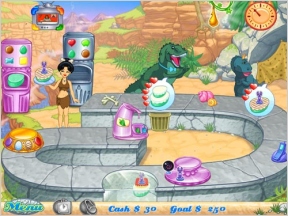
- #Supermarket mania 2 help walkthrough tips and tricks how to
- #Supermarket mania 2 help walkthrough tips and tricks drivers
#Supermarket mania 2 help walkthrough tips and tricks drivers
(The complete formula would be “Profits = (Price per unit * # of units sold) – [Fixed Costs + (Cost per unit * # of units produced).Īnd it puts this whole equation in a layered format so you can see what’s happening to the drivers of a company’s profits in different levels of abstraction. It basically breaks down the profits of a company into an equation: Profits = Revenues – Costs, and then that equation into more detailed variables. (And by the way, the right way to use Profitability trees is NOT by rehashing this old framework in every opportunity you have).Īs you can see, it is a very simple tool.
#Supermarket mania 2 help walkthrough tips and tricks how to
So, let’s start with it as a starting point on how to create and use profit trees to solve business problems. The Profitability Framework is the most basic form of a Profitability Tree. Section 2 is where advanced candidates will get the most value.įinally, in Section 3 I will show you a few examples of customized, applied profitability trees and break down what makes each of them great.

If you’re always breaking down PROFITS using the same drivers, regardless of industry and business situation, you’re missing so much nuance and information you will sound naive. This is the KEY STEP that everyone misses. In Section 2, I will show you how to customize your Profitability Tree.

In it I will show you how most people use Profit Trees, what is its underlying logic, why it’s different from a income statement and how to find the four core profit drivers in it. Section 1 will cover the basics of the Profitability Framework. I’ve broken down this guide in three sections: I’ll give you all the knowledge and tools you will need to master profitability trees so you can use them the right way.

Just like that, a Profitability Tree is useful for so many things that it becomes THE ONE problem-solving tool you must master if you want to learn to think like a McKinsey, Bain or BCG consultant and excel in your case interviews and your career. It’s a multipurpose tool every chef uses every day. It can be used for mincing, slicing, and chopping vegetables, slicing meat, and disjointing large cuts.” “A modern chef’s knife is a multi-purpose knife designed to perform well at many differing kitchen tasks, rather than excelling at any one in particular. Well, here’s a passage from Wikipedia’s article on the Chef’s Knife: If you’re not into cooking, you might be wondering why I’m making this analogy…

But they’re always useful because in any business situation that affects profits (which is pretty much all of them) you’ll want to know how that affects profits.Īnd because profitability trees are so ubiquitous, and yet so nuanced, I call them the “chef’s knife” of management consulting and business strategy. Sometimes they may be the primary tool, other times just a secondary one. (Or, get them wrong and you will seem like a fool.)Ģ) Profitability Trees can be used to solve pretty much any business problem. Get these nuances right and you’ll see insights faster than any person in the room. Profitability trees are a special kind of issue tree, that is created with the sole intent of analyzing the profits of a company.Īnd skillfully using Profitability Trees is the most efficient, direct way to understanding how a business makes profits and why it’s not making more of them.īefore we dive in, let me clear up the main objection people have against using Profitability Trees: that they’re too simple (and, so the logic implies, too simplistic).Īnd yes, a lot of people know about them.īut that doesn’t mean you should underestimate them.ġ) There are many, many nuances in how you can and should use Profit Trees to solve different problems.


 0 kommentar(er)
0 kommentar(er)
